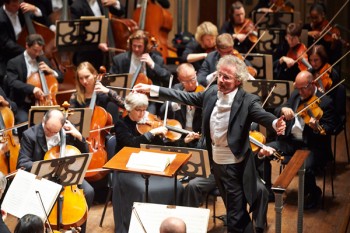by Timothy Robson

Petite musique solennelle might be “small,” but only in its five-minute duration. And although it pays homage to Boulez, the work in no way attempts to mimic the crystalline instrumental textures or dynamic rhythmic effects of Boulez’s own compositions. Kurtág’s homage is not in any typical way celebratory; it is more like a prescient funeral dirge — a solemn processional, with a more or less constant pulse. The sounds are mostly quiet, opening with several long unison notes before unfolding in somber timbres interspersed with mysterious, tuned percussion passages. Though Petite musique solennelle was effective and alluring as a pièce d’occasion for memorializing Boulez, it is hard to imagine Kurtág’s piece entering the common repertoire.
Norwegian cellist Truls Mørk made a welcome return at this concert as soloist in Robert Schumann’s Cello Concerto in a, Op. 129. Franz Welser-Möst and The Cleveland Orchestra treated the concerto almost as chamber music, which was ideal for Mørk’s refined but not huge sound.
Schumann wrote the concerto in 1850, but the first performance did not occur until after the composer’s death. The work is in three movements, connected musically and played without pause. The concerto is filled with beautiful melodic invention, and although there are dialogues between soloist and orchestra, the cello is often almost subsumed into the orchestral texture. The piece is concise and genial, and oversized dramatic effects are not to be found. Even the one cadenza is relatively brief — and accompanied by the orchestra, more a recitative than a cadenza. Truls Mørk was an ideal soloist in this stylish performance, a beautiful combination of delicacy and lyricism.
The audience responded with a warm if not thunderous ovation. Truls Mørk came back for an encore, the somber Sarabande from Johann Sebastian Bach’s Cello Suite No. 2 in d, BWV 1008.
If the first half of the concert could be described as “refined,” “lyrical,” and “delicate,” Anton Bruckner’s Symphony No. 6 in A was at the opposite end of the spectrum. The symphonies of Bruckner are a Franz Welser-Möst specialty, and in this performance, as he has in the past with others of Bruckner’s symphonies, Welser-Möst invested the music with an almost religious, white-hot passion. The performance was thrilling.
Though Bruckner’s orchestra is not vast, the way he uses it is idiosyncratic in its layering of sounds and use of instrumental groups as sonic building blocks, particularly the brass section, which he uses for maximum bombast and rarely as solo instruments. Bruckner was both a devout Catholic and an acclaimed organist and improviser; his orchestrations closely match how an organist would choose registrations on a large, Romantic-style organ.
A triplet figure dominates the first movement’s rhythms. Long sequences of harmonic dissonances and resolutions allow Bruckner to make excursions into fairly remote tonal areas. Amazing crescendos that rise to blazing fanfares dissipate quickly to intimate pianissimos. Sometimes Brucker simply pauses the action for a moment of silence, allowing him to reset the pulse and harmony for the next section. And sometimes the movements don’t end traditionally — the music just stops. The second movement is serene, with many beautiful melodies. The third movement is playful in the woodwinds, as well as heroic in the brass. The fourth movement is a demonstration of Bruckner’s skill at weaving complex, lengthy movements out of modest musical motifs. Mostly a march, Bruckner plays with the contrast between minor keys and the A-major tonality of the symphony as a whole.
Anton Bruckner’s symphonies may be monumental in conception and duration, but the odd effect that they have — at least on this listener — is that at the end, time has vanished and it is a surprise when the symphony comes to an end. That was certainly the case in this performance, in which The Cleveland Orchestra invested themselves wholeheartedly in Franz Welser-Möst’s vision of the piece.
Published on ClevelandClassical.com March 28, 2016.
Click here for a printable copy of this article



